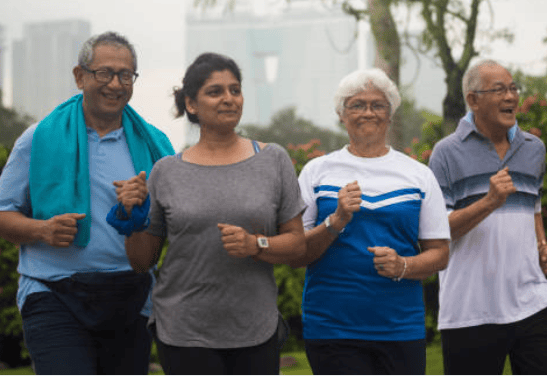The 100-mile a Month Walking Challenge: Take the First Step to a Healthy Life
You want to get healthier, lose weight, feel younger, and improve your overall wellness, but you have some reservations.
Perhaps you can’t afford a gym membership or expensive equipment. Maybe you’re too embarrassed to go to a gym or simply don’t want gym equipment cluttering your home. (Who hasn’t had a piece of gym equipment become an expensive clothes rack when it’s located in your bedroom?) How do you break away from bad habits?
The simple solution to your dilemma is starting a walking regimen. If you can commit just an hour a day (and it does not need to be in one solid block) to your health and fitness, you can begin a walking challenge that can transform your life.
Everyone who truly wants to be healthier can find an hour – and an hour is all you need to begin to lose weight, feel younger, and improve your wellness. If you truly want to improve your life, you’ll find something you can give up to find that hour. Don’t let weak excuses get in the way of good intentions.
Some folks get up an hour earlier and walk in the morning. (I tried that, but I found walking in the darkness of the early morning hard to do.) Some folks give up their lunch hour, bringing a change of clothes and walking during their break. (This solution also is good for people who are dieting, as they tend to eat a smaller lunch.) Some folks walk after work in the late afternoon or early evening. (This timeframe also helps with the transition from being in work mode to being at home.) Finally, some people walk late at night, after dinner. (The problem with this schedule is that people are often too tired to even walk. As with early morning walks, late evening walks are also a bit more dangerous because of the darkness.)
When you find that hour a day – and you walk at a brisk pace – you should be able to walk about 6,000 steps, or about 3 miles. Giving yourself a few days off from walking each month to should still result in your walking about 75 miles each month.
So, how do you reach that 100-mile mark? You reach the 100-mile mark when you also factor in the walking you do during your normal daily routine. The average person walks about 2,000 steps a day – which means an additional 30 miles a month – making your combined walking roughly 100 miles.
What about 10,000 steps? You may have heard the buzz about walking 10,000 steps a day. Well, with this plan you’re up to 8,000 steps per day – the 2,000 from your normal routine and the 6,000 from your hourly walk. How can you achieve the 10,000 steps (which would also push your monthly walking totals to close to 150 miles)?
Add More Steps to Daily Routine
Suggestions for adding more steps to your daily routine:
Walk to work or school (or get off the bus or subway a few blocks early and walk the distance)
Walk or pace while talking on the phone
Walk to the store, post office, a neighbor’s house, or for other nearby errands
Walk down the hallway to visit with a classmate, teacher, or co-worker
Take the stairs – at least for a few flights – rather than the elevator
Use a restroom, copy room, or break room farther from your desk – or even find one on a different floor (but only if you take the stairs)
Park your car farther from stores and walk the difference
Get up to change the channel – and walk around during commercial breaks
Benefits of a Walking Fitness Regimen
According to health experts, there are many benefits of walking, including:
Burning calories (approximately 300 per 1-hour walk), losing/maintaining weight, and trimming inches off hips or waist
Lowering blood pressure
Improving cardiovascular health (lowering the risk of heart disease and strokes)
Lessening the risk of type 2 diabetes
Fighting the risk of cancers (especially breast and colon cancer)
Reducing stress and anxiety
Boosting self-esteem
Improving mental health, mood, and outlook
Staving off degenerative diseases such as Alzheimer’s and arthritis
Building stronger bones
Reducing the risk of disabilities
Increasing energy levels
Enhancing sleep
Improving overall health and wellness
How to Get Started Walking
As with any kind of fitness program, start slowly – and always check with your doctor before you begin.
The great thing about walking is that you don’t much to get started – find a good pair of shoes (ones that provide support) and some comfortable clothing. Some people buy a device or app to accurately measure their steps. You also might want a walking log to track your progress. Finally, some people enjoy the solitude (perhaps also playing music with a strong beat for brisk strides), while others prefer walking with friends – walking buddies who can keep you motivated and on pace.
Your goal is to gradually get to the one hour of daily walking, adding 10 minutes – 1,000 steps -- to your walking regimen each week. Try to walk at least 5 of the 7 days of the week. Remember to warm up before walking – and consider some stretching and flexibility exercises to avoid any potential injuries. Toward the end of longer walks, remember to include a short cool-down period.
Week 1: Start by walking briskly for 10 minutes daily (1,000 steps)
Week 2: Walk briskly for 20 minutes daily (2,000 steps)
Week 3: Walk briskly for 30 minutes daily (3,000 steps)
Week 4: Walk briskly for 40 minutes daily (4,000 steps)
Week 5: Walk briskly for 50 minutes daily (5,000 steps)
Week 6: Walk briskly for 60 minutes daily (6,000 steps)
Week 7+: Continue walking briskly for 60 minutes daily (6,000 steps)
Final Thoughts on a Walking Challenge
The easiest – and perhaps safest – way to start feeling better and becoming more fit is to simply start walking. By making a small commitment – one hour per day for most of every week – you’ll gain much more in looks, confidence, and overall health and wellness.
Remember to have rest days to give your body a chance to recover. It’s also a good idea to add a few days of resistance (weight) training each month. You can also mix things up by adding bicycling, yoga, dance, and swimming to the mix of your fitness program.
For a change of pace and to increase your aerobic benefit from walking, consider implementing interval walking once or twice a week. In interval walking, you walk extremely briskly for a few minutes, followed by regular walking, followed by another short period of brisk walking, followed by regular walking. (For example, complete a 5-minute very fast walk, followed by a 15-minute normal pace, followed by a 10-minute brisk walk, followed by a 15-minute normal pace, followed by a 5-minute very fast walk, followed by a 15-minute normal pace and cool down.)
Finally, while walking you might also consider doing mini-standing ab crunches (sucking your gut in and tightening your buttocks) and increasing your arm movements.
Find more details see my article, 10 Critical Walking Tips, which includes key safety tips, walking resources, and more.
Dr. Randall Hansen is an advocate, educator, mentor, ethicist, and thought-leader... helping the world heal from past trauma. He is founder and CEO of EmpoweringSites.com, a network of empowering and transformative Websites, including EmpoweringAdvice.com.
He is the author of the groundbreaking Triumph Over Trauma: Psychedelic Medicines are Helping People Heal Their Trauma, Change Their Lives, and Grow Their Spirituality and the well-received HEAL! Wholeistic Practices to Help Clear Your Trauma, Heal Yourself, and Live Your Best Life.
His latest book is a true game-changer: The HEALing Revolution Diet: A Science-based Approach to Heal Your Gut, Reverse Chronic Illnesses, Lose Weight, Clear Your Mind, and Increase Longevity.
Dr. Hansen's focus and advocacy center around true healing ... healing that results in being able to live an authentic life filled with peace, joy, love. Learn more by visiting his personal Website, RandallSHansen.com. You can also check out Dr. Randall Hansen on LinkedIn.








